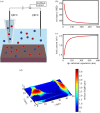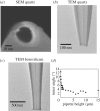Multifunctional scanning ion conductance microscopy
- PMID: 28484332
- PMCID: PMC5415692
- DOI: 10.1098/rspa.2016.0889
Multifunctional scanning ion conductance microscopy
Abstract
Scanning ion conductance microscopy (SICM) is a nanopipette-based technique that has traditionally been used to image topography or to deliver species to an interface, particularly in a biological setting. This article highlights the recent blossoming of SICM into a technique with a much greater diversity of applications and capability that can be used either standalone, with advanced control (potential-time) functions, or in tandem with other methods. SICM can be used to elucidate functional information about interfaces, such as surface charge density or electrochemical activity (ion fluxes). Using a multi-barrel probe format, SICM-related techniques can be employed to deposit nanoscale three-dimensional structures and further functionality is realized when SICM is combined with scanning electrochemical microscopy (SECM), with simultaneous measurements from a single probe opening up considerable prospects for multifunctional imaging. SICM studies are greatly enhanced by finite-element method modelling for quantitative treatment of issues such as resolution, surface charge and (tip) geometry effects. SICM is particularly applicable to the study of living systems, notably single cells, although applications extend to materials characterization and to new methods of printing and nanofabrication. A more thorough understanding of the electrochemical principles and properties of SICM provides a foundation for significant applications of SICM in electrochemistry and interfacial science.
Keywords: cellular imaging; charge mapping; electrochemical imaging; nanopipette; scanning ion conductance microscopy; single-cell analysis.
Conflict of interest statement
We declare we have no competing interests.
Figures














Similar articles
-
Frontiers in Nanoscale Electrochemical Imaging: Faster, Multifunctional, and Ultrasensitive.Langmuir. 2016 Aug 16;32(32):7993-8008. doi: 10.1021/acs.langmuir.6b01932. Epub 2016 Aug 3. Langmuir. 2016. PMID: 27396415
-
Differential-Concentration Scanning Ion Conductance Microscopy.Anal Chem. 2017 Nov 21;89(22):12458-12465. doi: 10.1021/acs.analchem.7b03543. Epub 2017 Oct 31. Anal Chem. 2017. PMID: 28992688
-
Simultaneous noncontact topography and electrochemical imaging by SECM/SICM featuring ion current feedback regulation.J Am Chem Soc. 2010 Jul 28;132(29):10118-26. doi: 10.1021/ja1029478. J Am Chem Soc. 2010. PMID: 20590117
-
Scanning Ion Conductance Microscopy.Chem Rev. 2021 Oct 13;121(19):11726-11768. doi: 10.1021/acs.chemrev.0c00962. Epub 2020 Dec 9. Chem Rev. 2021. PMID: 33295182 Free PMC article. Review.
-
Probing and Visualizing Interfacial Charge at Surfaces in Aqueous Solution.Annu Rev Anal Chem (Palo Alto Calif). 2022 Jun 13;15(1):247-267. doi: 10.1146/annurev-anchem-121521-122615. Epub 2022 Mar 8. Annu Rev Anal Chem (Palo Alto Calif). 2022. PMID: 35259914 Review.
Cited by
-
Bioelectrical understanding and engineering of cell biology.J R Soc Interface. 2020 May;17(166):20200013. doi: 10.1098/rsif.2020.0013. Epub 2020 May 20. J R Soc Interface. 2020. PMID: 32429828 Free PMC article.
-
On the intersection of electrochemistry and mass spectrometry.Curr Opin Electrochem. 2019 Feb;13:140-146. doi: 10.1016/j.coelec.2018.12.001. Epub 2018 Dec 13. Curr Opin Electrochem. 2019. PMID: 33981910 Free PMC article.
-
Charge Mapping of Pseudomonas aeruginosa Using a Hopping Mode Scanning Ion Conductance Microscopy Technique.Anal Chem. 2023 Mar 28;95(12):5285-5292. doi: 10.1021/acs.analchem.2c05303. Epub 2023 Mar 15. Anal Chem. 2023. PMID: 36920847 Free PMC article.
-
AI-Assisted Fusion of Scanning Electrochemical Microscopy Images Using Novel Soft Probe.ACS Meas Sci Au. 2022 Aug 19;2(6):576-583. doi: 10.1021/acsmeasuresciau.2c00032. eCollection 2022 Dec 21. ACS Meas Sci Au. 2022. PMID: 36785775 Free PMC article.
-
Scanning ion conductance microscopy of live human glomerulus.J Cell Mol Med. 2021 May;25(9):4216-4219. doi: 10.1111/jcmm.16475. Epub 2021 Mar 21. J Cell Mol Med. 2021. PMID: 33745233 Free PMC article.
References
-
- Hansma PK, Drake B, Marti O, Gould SA, Prater CB. 1989. The scanning ion-conductance microscope. Science 243, 641–643. (doi:10.1126/science.2464851) - DOI - PubMed
-
- Korchev YE, Bashford CL, Milovanovic M, Vodyanoy I, Lab MJ. 1997. Scanning ion conductance microscopy of living cells. Biophys. J. 73, 653–658. (doi:10.1016/S0006-3495(97)78100-1) - DOI - PMC - PubMed
-
- Gorelik J, et al. 2004. The use of scanning ion conductance microscopy to image A6 cells. Mol. Cell. Endocrinol. 217, 101–108. (doi:10.1016/j.mce.2003.10.015) - DOI - PubMed
-
- Chen C-C, Zhou Y, Baker LA. 2012. Scanning ion conductance microscopy. Annu. Rev. Anal. Chem. 5, 207–228. (doi:10.1146/annurev-anchem-062011-143203) - DOI - PubMed
-
- Meyer E, Hug HJ, Bennewitz R. 2013. Scanning probe microscopy: the lab on a tip. Berlin, Germany: Springer Science & Business Media.
Publication types
LinkOut - more resources
Full Text Sources
Other Literature Sources

